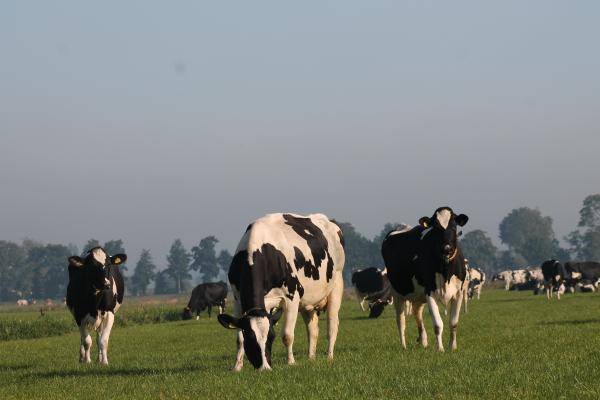Claw problems are one of the main reasons for the early removal of dairy cows. They have a negative effect on the milk production, feed intake, fertility, longevity and the welfare of the cows. Claw problems cost farmers an average of €53 per cow present. Finding the exact cause of claw problems is usually no mean feat.
[Written by: J. Koppes MSc. - Dr I Gantois]
Claw problems can be divided into infectious and non-infectious diseases.
-
Infectious conditions such as Mortellaro are usually the result of reduced resistance and unfavourable environmental factors (humidity, poor hygiene…).
-
Non-infectious conditions such as sole ulcers and white line defects are more likely to be caused by the ration and housing (excessively hard floor, overcrowding…).
Sufficient attention for management factors is therefore crucial in tackling claw problems. The Dutch GD has made a 7-step plan for this:
-
barn floor and cubicles,
-
checking the claws,
-
treatment of lame cows,
-
disinfection
-
breeding and disposal,
-
body condition
-
ration.
Body condition
Research shows that lean cows have thinner fat pads on their claws and are more likely to be lame. Fat pads protect the claw, distribute the weight and provide better cushioning.
Managing for a correct body condition can therefore contribute to staying ahead of claw problems. Especially around the transition period, it is important to keep the body condition optimal. One guideline for this is to start the dry period with a body condition score (BCS) of 3 to 3.5. It is important to keep this stable until calving. After calving, it is important to limit the negative energy balance (NEB). Cows with an NEB also mobilise the fat stored in the claw. Good transition management is therefore a requirement. To keep the BCS optimal, a correctly adjusted ration is required.
A good ration
In the interest of good claw health, fresh and tasty feed should be provided daily during the dry period and lactation period. Because a clear link exists between the NEB and claw problems, it is important that dry cows do not get fat. It is therefore recommended to give low-energy feed during the dry period.
At the start of lactation, it is important to gradually build up the concentrate supply. This is to prevent rumen acidosis from occurring. During rumen acidosis or acidosis, lactic acid, histamine and endotoxins, among other things, are produced in the rumen. These substances can affect the blood supply and the absorption of nutrients in the claw (laminitis).
Sudden ration changes, too much concentrate, insufficient structure and too many fast carbohydrates increase the risk of rumen acidosis. Providing adequate rumen buffering can help prevent rumen acidosis. Do keep in mind that claw problems usually only occur 6-8 weeks after the nutritional disruption. Rumen acidosis may no longer be a factor at that point.
Vitamins and minerals
An optimal supply of vitamins and minerals contributes to healthy skin tissue and hard claw horn. These must be supplemented via the feed concentrate and/or mineral mixture.
Zinc, manganese and copper are the most important trace elements to keep an eye on.
-
Zinc mainly plays a role in the formation of keratin, the building block of the claw horn. Furthermore, this trace element is also involved in the protection of the lipid-rich extracellular matrix (= the cement between the keratin cells).
-
Manganese is essential for the formation of high-quality bone and cartilage. This element is also involved in the keratin formation of the horn cells and in the formation of connective tissue.
-
Copper is also involved in the maintenance of healthy claw horn.
Several studies report reduced zinc, manganese, copper and calcium content in the claw in cows with claw problems. The bioavailability of these minerals may also affect claw disease. For example, several studies show that the incidence of lame cows is lower when using the more available, organic trace elements.
Biotin or vitamin H is directly involved in claw formation. This vitamin helps to form the cement that holds the horn cells together. However, biotin is only produced to a very limited extent via rumen synthesis. That is why adding more biotin to the ration offers clear added value.
The recommended dosage for biotin is 20 mg/cow/day. Several studies show a reduction in the number of non-infectious claw problems at this dose. Studies also show an increased milk production of 1.3 kg of milk per day on average with the administration of 20 mg biotin per cow/day. It may take several months for the effects of biotin on claw health to become apparent because the process to make new horn tissue takes 6 to 8 weeks.
Conclusions
In addition to management factors, nutrition plays an important role in the claw health of dairy cows. As a preventive measure, it is important to keep the cow's body condition in good order and to prevent rumen acidosis. It is essential to supplement the vitamins and minerals via the concentrates and/or mineral mix, in amounts adjusted for the ration.
TWILMIX Cattle Claw Excellent is a cattle mineral that provides cows with this. This mineral contains vitamins, trace elements and buffers to support excellent claw health. Other, e.g. customer-specific Rovisol mineral mixtures, can also be developed for this purpose. In addition, the GD can measure, among other things, trace elements and biotin in the bulked milk. This can provide a good indication of whether the levels in the total ration are as they should be.


